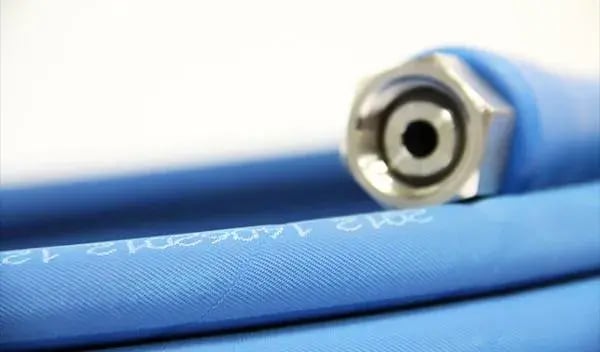I’m looking for a high-pressure hose. Which is the best one for me to choose?

High-pressure cleaning in the food industry is necessary if your machines and areas are made very dirty by the production process. Think of fat residues, blood residues and baked-on dirt. Such dirt mainly occurs when processing meat and potatoes. You can only clean it away effectively with high pressure (from 60 bar) in combination with a high water temperature. Elpress recommends a ½-inch hose with textile layer and a black outer wall for high-pressure cleaning.
1/2-inch high-pressure hose
A ½-inch hose is always used for high-pressure cleaning. For rinsing alone, a ⅜-inch hose is sufficient. This thin hose is easy to use and uses about 18 to 20 litres of water per minute per employee at a working pressure of 60 bar. By comparison: medium pressure (40 bar) uses 25 litres of water per minute and low pressure (40 bar) uses 30 litres of water. Using a hose with a larger diameter in combination with high-pressure cleaning is not advisable because this requires much more effort at the expense of easy working.
Textile layer or steel layer
When buying a cleaning hose, you have the choice between a hose with textile layer or a hose with steel layer. In principle, a textile layer is preferred because it is more flexible and more durable. This synthetic material does not degrade and is very wear-resistant.
Potato processors and meat processors generally choose a hose with a black inner wall (NBR hose) because the water used for cleaning – at the end of the production process – does not come into contact with the food.
Avoiding damage caused by high pressure
As mentioned at the start of this blog, high-pressure cleaning is not always necessary. High-pressure cleaning (from 60 bar) can damage equipment. Think of conveyor belts, electronics, weigh scales and plug sockets. At a lower pressure, the chance of damage is much lower. So check whether high-pressure cleaning is really necessary or whether it is possible to clean at a lower pressure in combination with more water.
Tailored advice for a high-pressure hose
Would you like appropriate advice about a high-pressure hose for your company’s cleaning process? Our specialists would be pleased to help!
.webp)





